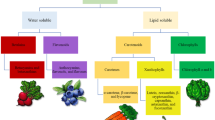Abstract
The research evidences the importance of linking chemical and sensory data for the wine characterization; in particular, the Italian white wine made from Inzolia grapes has been considered. Inzolia is one of the most widespread native white grapes in Sicily (Italy), and wine samples from two different areas (Monreale and Sambuca di Sicilia) have been analyzed. A headspace solid-phase microextraction/gas chromatography–mass spectroscopy method has been developed, and 56 volatile components, esters, fatty acids, alcohols, and terpenes have been identified; the method allows also the quantification of the main components, namely, ethyl octanoate (banana, fruit, fat) (257.2–541.6 mg/l) and ethyl decanoate (fruity, oily, floral; 171.8–272.0 mg/l). A good repeatability in terms of retention times and peak areas resulted. Sensory analysis was performed by ten trained judges that evaluated eight attributes: two referring to appearance (yellow color and yellow reflex), four referring to aroma (fruity, banana, ripened apple, and floral), and two referring to oral perception (acid and pungent). The volatile constituents and the aroma sensory attributes were in agreement.


Similar content being viewed by others
References
Alves RF, Nascimento AMD, Nogueira JMF (2005) Characterization of the aroma profile of Madeira wine by sorptive extraction techniques. Anal Chim Acta 546:11–21
Arvanitoyannis IS, Katsota MN, Psarra EP, Soufleros EH, Kallithraka S (1999) Application of quality control methods for assessing the wine authenticity: use of statistical (multivariate) analysis. Trends Food Sci Technol 10:321–336
Ashurst PR (1999) In: Food flavorings. Chapman and Hall, New York
Begala M, Corda L, Podda G, Fedrigo MA, Traldi P (2002) Headspace solid-phase microextraction gas chromatography/mass spectrometry in the analysis of the aroma constituents of “Cannonau of Jerzu” wine. Rapid Commun Mass Spectrom 16:1086–1091
Bonino M, Schellino R, Rizzi C, Aigotti R, Delfini C, Baiocchi C (2003) Aroma compounds of an Italian wine (Ruche) by HS-SPME analysis coupled with GC–IT-MS. Food Chem 80:125–133
Cabaroglu T, Canbas A (2002) The effect of skin contact on the aromatic composition of the white wine of Vitis vinifera L. CV. Muscat of Alexandria grown in Southern Anatolia. Acta Aliment 31:45–55
Clarke RJ, Bakker J (2004) In: Wine flavour chemistry. Blackwell, Oxford
De la Calle Garcia D, Reichenbaecher M, Danzer K, Hurlbeck C, Bartzsch C, Feller KH (1998) Analysis of wine bouquet components using headspace solid-phase microextraction–capillary gas chromatography. J High Res Chromatogr 21:373–377
Demyttenaere JCR, Dagher C, Sandra P, Kallithraka S, Verhe R, De Kimpe N (2003) Flavor analysis of Greek white wine by solid-phase microextraction–capillary gas chromatography–mass spectrometry. J Chromatogr A 985:233–246
Dugo P, Saitta M, Dugo G, Bambara G, Piccolo F, Capraro F, Genduso P (1994) Aromatic profiles of Sicilian wines. II. Volatile and aromatic components of wines made from botrytized grapes grown in Sicily. Riv Ital Scienza Alimentazione 23:215–225
Ferreira ACS, Lopez R, Cacho JF (2000) Quantitative determination of the odorants of young red wines from different grape varieties. J Sci Food Agric 80:1659–1667
Guth H (1997) Quantitation and sensory studies of character impact odorants of different white wine varieties. J Agric Food Chem 45:3027–3032
Kallithraka S, Arvanitoyannis IS, Kefalas P, El-Zajouli A, Soufleros E, Psarra EP (2001) Instrumental and sensory evaluation of Greek red and white wines; implementation of principal component analysis for classification according to geographic origin. Food Chem 73:501–514
Karagiannis S, Economou A, Lanaridis P (2000) Phenolic and volatile composition of wines made from Vitis vinifera Cv. Muscat lefko grapes from the island of Samos. J Agric Food Chem 48:5369–5375
Lawless H (1995) Dimensions of sensory quality: a critique. Food Qual Prefer 6:191–199
López R, Aznar M, Cacho J, Ferreira V (2002) Determination of minor and trace volatile compounds in wine by solid-phase extraction and gas chromatography with mass spectrometric detection. J Chromatogr A 966:167–177
Maarse H (1991) In: Volatile compounds in food and beverages. Marcel Dekker, New York
Mestres M, Busto O, Guasch J (2002) Application of headspace solid-phase microextraction to the determination of sulphur compounds with low volatility in wines. J Chromatog A 945:211–219
Moskowitz H (1995) Food quality: conceptual and sensory aspects. Food Qual Prefer 6:157–162
Muñoz M (2002) Sensory evaluation in quality control: an overview, new developments and future opportunities. Food Qual Prefer 13:329–339
Noble AC, Arnold RA, Buechsenstein J, Leach EJ, Schimdt JO, Stern PM (1987) Modification of a standardized system of wine aroma terminology. Am J Enol Vitic 38:143–146
Ong PKC, Acree TE (1999) Similarities in the aroma chemistry of Gewuerztraminer variety wines and lychee (Litchi chinensis Sonn.) fruit. J Agric Food Chem 47:665–670
Palomo E, Sanchez D-M, Vinas MC, Gonzalez MA, Soriano-Perez A, Perez-Coello MS (2006) Aroma profile of wines from Albillo and Muscat grape varieties at different stages of ripening. Food Control 18:398–403
Perez-Prieto LJ, Lopez-Roca JM, Gomez-Plaza E (2003) Differences in major volatile compounds of red wines according to storage length and storage conditions. J Food Comp Anal 16:697–705
Randazzo C, Restuccia C, Lanza CM, Tomaselli F, Giudici P, Corte V, Melia V (1998) Aroma compounds as discriminating factors for Grecanico and Inzolia wines. Vignevini 25:90–94
Van den Dool H, Kratz PD (1963) A generalization of the retention index system including linear temperature programmed gas–liquid partition chromatography. J Chromatogr 11:463–471
Varela P, Gàmbara P (2006) Sensory descriptive analysis of Uruguaian Tannat wine: correlation to quality assessment. J Sens Stud 21:203–217
Vernin G, Pascal-Mousselard H, Metzger J, Parkanyi C (1993) Aromas of Mourvèdre wines. In: Charalambous G (ed) Shelf-life studies of food and beverages. Developments in food science no. 33. Elsevier, Amsterdam
Verzera A, Ziino M, Condurso C, Romeo V, Zappalà M (2004) Solid-phase microextraction and gas chromatography–mass spectrometry for rapid characterisation of semi-hard cheeses. Anal Bioanal Chem 380:930–936
Vilanova M (2006) Sensory descriptive analysis and consumer acceptability of Godello wines from Valdeorras Appellation Origen Controlée (NorthWest Spain). J Sens Stud 21:362–372
Author information
Authors and Affiliations
Corresponding author
Rights and permissions
About this article
Cite this article
Verzera, A., Ziino, M., Scacco, A. et al. Volatile Compound and Sensory Analysis for the Characterization of an Italian White Wine from “Inzolia” Grapes. Food Anal. Methods 1, 144–151 (2008). https://doi.org/10.1007/s12161-008-9027-2
Received:
Accepted:
Published:
Issue Date:
DOI: https://doi.org/10.1007/s12161-008-9027-2




